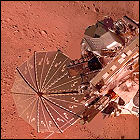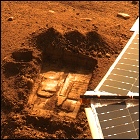Phoenix successfully lands on Mars
 Radio signals from the Martian surface indicating the successful landing of NASA’s unmanned Phoenix probe near the north pole of Mars. (To put this feat in perspective: the past several unmanned probes to land safely on Mars used a “bouncing airbag” approach; the last time a lander actually made it to the surface intact with braking thrusters and landing pads – and no airbags – was in 1976, when NASA’s Viking 1 and 2 landers successfully touched down on the planet.) The first stationary (i.e. non-rover) Mars lander since the Viking probes of the 1970s, Phoenix will stay in one spot to conduct three months of studies. Also like the Vikings, Phoenix has a soil-sampling arm and an on-board laboratory to help it determine the presence of water or water ice in its polar vicinity.
Radio signals from the Martian surface indicating the successful landing of NASA’s unmanned Phoenix probe near the north pole of Mars. (To put this feat in perspective: the past several unmanned probes to land safely on Mars used a “bouncing airbag” approach; the last time a lander actually made it to the surface intact with braking thrusters and landing pads – and no airbags – was in 1976, when NASA’s Viking 1 and 2 landers successfully touched down on the planet.) The first stationary (i.e. non-rover) Mars lander since the Viking probes of the 1970s, Phoenix will stay in one spot to conduct three months of studies. Also like the Vikings, Phoenix has a soil-sampling arm and an on-board laboratory to help it determine the presence of water or water ice in its polar vicinity.

 NASA’s Phoenix lander samples the soil of Mars, and it finds not only water, but an unusual soil composition which would make living off the land unlikely for human travelers. The soil sample in question contains perchlorate, a chemical used on Earth to make solid rocket fuel. So while a hypothetical Mars colony couldn’t use the planet’s own soil for farming, it could certainly launch a rocket or two. But missions scientists are quick to point out that while the presence of perchlorate in the Martian dirt may be unfriendly to humans, there may still have been life on the planet at some point which adapted to that chemical; it may also be a localized phenomenon unique to Phoenix’s polar landing site. (There are some plants on Earth capable of processing perchlorate-infused soil, but they’re generally not regarded as viable crops.) The Phoenix probe’s mission is extended to the end of September so it can continue its studies, and could be extended again at the end of that period, though the harsh Martian winter is likely to deny the non-roving Phoenix the kind of longevity enjoyed by its more mobile siblings, Spirit and Opportunity.
NASA’s Phoenix lander samples the soil of Mars, and it finds not only water, but an unusual soil composition which would make living off the land unlikely for human travelers. The soil sample in question contains perchlorate, a chemical used on Earth to make solid rocket fuel. So while a hypothetical Mars colony couldn’t use the planet’s own soil for farming, it could certainly launch a rocket or two. But missions scientists are quick to point out that while the presence of perchlorate in the Martian dirt may be unfriendly to humans, there may still have been life on the planet at some point which adapted to that chemical; it may also be a localized phenomenon unique to Phoenix’s polar landing site. (There are some plants on Earth capable of processing perchlorate-infused soil, but they’re generally not regarded as viable crops.) The Phoenix probe’s mission is extended to the end of September so it can continue its studies, and could be extended again at the end of that period, though the harsh Martian winter is likely to deny the non-roving Phoenix the kind of longevity enjoyed by its more mobile siblings, Spirit and Opportunity.